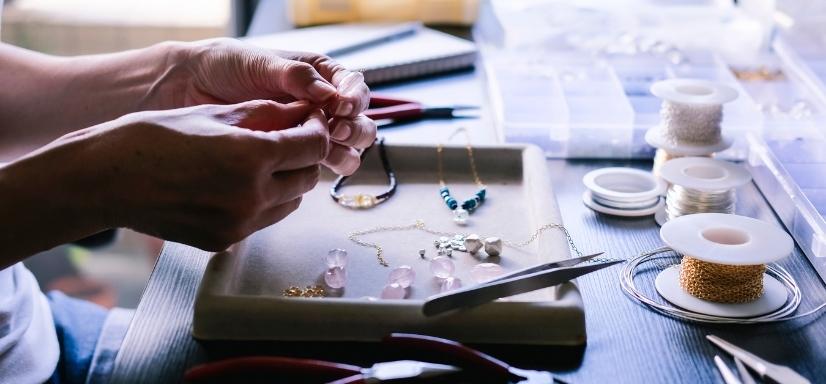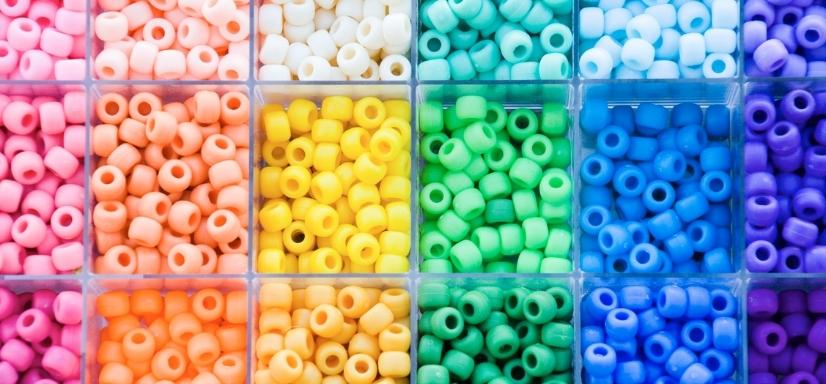How to Organize and Track Your Jewelry Inventory (+ Free Template)
We show you how to track your small jewelry business inventory with ease.

If you own a small jewelry business, keeping track of your inventory is essential to your success. But it can be difficult to stay organized, especially if you have a large number of materials or if you’re selling through multiple channels.
In this article, we’ll give you some tips and tricks for getting your jewelry inventory organized. We’ll also show you how to use a spreadsheet to track your inventory (and give you a free template to get yourself started ASAP!)
By the end of this article, you’ll have everything you need to get your jewelry inventory finally under control!
Ready to take your jewelry business to the next level?
Try Craftybase: the award winning inventory software for jewelry makers. Automatic stock tracking, COGS, pricing guidance and much more.
Guaranteed to skyrocket your profit margins
Why tracking inventory is important for a small jewelry business

As a small jewelry business owner, you know that time is money.
And when it comes to your inventory, knowing what you have on hand (and where it is) can save you a lot of time and money in the long run.
For example, let’s say you’re selling jewelry through both your online store and at craft fairs.
If you don’t have a good system for tracking your inventory, it’s easy to lose track of what you have on hand.
This can lead to problems like:
- Overselling an item and then being unable to fulfill an order
- Not having the right materials on hand when you need to make a product
- Wasting time and money searching for misplaced inventory
- Having too much money tied up in raw materials that are gathering dust on the shelf
In other words, not tracking your inventory can cost you both time and money - two things that are precious commodities for any small business owner.
Taking control of your small jewelry business inventory management is the first step in building a business that will generate the profits and results you truly want (and deserve!).
So, let’s get started!
What counts as jewelry inventory?

Before we get into the nitty-gritty of inventory management, let’s take a quick minute to review what counts as “inventory” for a jewelry business.
Generally speaking, your jewelry inventory will include all the materials you use to make your jewelry and any finished pieces you have on hand.
This might include things like:
- Beads
- Stones
- Findings
- Wire
- Finished jewelry
- Packaging materials
Essentially, anything that you use to make or sell your jewelry should be included in your inventory management strategy.
It’s also important to factor in samples and test products into your jewelry inventory - although you may account for the production cost in slightly different ways, at the end of the day you still need to track materials and their production in exactly the same way as your regular products.
Tips and tricks for getting your jewelry inventory organized
Create a proper labeling system for everything

One of the best ways to get your jewelry inventory organized is to create a proper labeling system for everything you have on hand.
This will help you keep track of what you have on the shelf and make it easier to find things when you need them.
Create clear and visible labels that show, at a minimum, the code for the item, and the name you use to refer to it.
For your coding system, you might like to use SKUs - these are unique codes that you assign to each of your products, and they can be helpful in several ways through your entire production process. For an example of creating a SKU, you might label your beads with a number (1 for white beads, 2 for black beads, etc.) and then use letters to indicate the type of bead (R for round, S for square, etc.).
You can also use color coding to help you keep track of things - for example, you might use different colored labels or boxes to indicate different types of materials.
The important thing is to find a labelling system that works for you and that you can stick to.
Make sure your workshop space is organized and tidy

Another helpful tip for getting your jewelry inventory organized is to make sure your workshop space is tidy and well-organized.
This might seem like a no-brainer, but it’s amazing how much of a difference having a tidy workspace can make when it comes to keeping track of your inventory.
When everything has its place and you know where to find things, it’s much easier to keep track of what you have on hand.
Conversely, when your workshop is a mess it’s all too easy for things to get lost in the shuffle - and that can quickly lead to inventory problems.
So take some time to tidy up your workspace and make sure everything has its own place.
You might even want to consider investing in some storage solutions specifically for your jewelry-making supplies.
Keep an accurate inventory log
Another helpful tip for your jewelry inventory management is to maintain an accurate inventory log.
This can be a simple spreadsheet where you track all the materials you have on hand and any finished jewelry. If you have a lot of raw materials or sell on multiple channels, you might like to also investigate using specialized inventory software for jewelry makers.
For each item, be sure to include:
- The SKU
- A description
- The quantity
- Where it’s being stored
- Any special notes
You might also want to include columns for the date you acquired the item, the date it was used, and the cost. This will help you track your costs of production and COGS.
If you sell your jewelry online, through consignment or at craft fairs, you’ll also want to keep track of your sales so that you can accurately adjust your inventory levels.
Use consistent measurement units for tracking your inventory
Another important tip for tracking your jewelry inventory is to use consistent measurement units.
This might seem like a small detail, but it can make a big difference when it comes to keeping accurate records.
For example, let’s say you want to track how much gold you have on hand.
If you measure some pieces in grams, others in troy ounces, and still others in pennyweights, it will be much harder to track your overall gold inventory.
The important thing is to be consistent in the units you use so that you can easily track and compare your inventory levels.
Stocktake or cycle count as often as you need to maintain accuracy
Another helpful tip for keeping track of your jewelry inventory is to perform regular stocktakes or cycle counts.
This involves physically counting all the items in your inventory and comparing them against your records.
This is important because it helps you catch any errors in your records and ensures that your inventory levels are accurate.
How often you perform stocktakes or cycle counts will depend on the size of your inventory and how often it changes.
If you have a small, static inventory, you might only need to do it once a year.
But if you have a large or dynamic inventory, you might need to do it monthly, weekly, or even daily - the important thing is to find a schedule that works for you and that you can stick to.
See also: How to cycle count your inventory
Use your inventory data to buy your raw materials, when you need them
A final tip for tracking your jewelry inventory is using your inventory data to help you buy your raw materials rather than impulse or using guestimates.
Your aim for your inventory management flow to ensure you have the raw materials on hand before you need to use it, but not too far in advance that they tie up your cashflow.
Offload your unneeded inventory
If you find that you have more inventory than you need, it might be worth considering offloading some of it.
There are a few different ways you can do this:
- Sell it to another jewelry business
- Create test or limited edition products
- Donate it to a charity
- Scrap
- Return for store credit
Ensure you use the inventory data you are creating to improve your processes
An important part of your inventory management strategy is using the data you collect to improve your processes.
For example, if you find that you’re constantly running out of a certain type of findings, you might need to adjust your production schedule or buy more in advance.
Or if you notice that you have a lot of inventory sitting in your storeroom, you might need to rethink your stocking levels.
The important thing is to use the data you’re collecting to improve your business and make it more efficient.
Using spreadsheets to track your jewelry inventory
If you’re just getting started with tracking your inventory, using a spreadsheet is a great place to start.
This will give you a chance to get used to the process and ensure you’re recording all the information you need without spending a lot of money on specialized software.
There are several different ways you can set up your spreadsheet, but we recommend starting with a simple table that includes the following columns:
- SKU
- Description
- Quantity
- Location
- Cost
- Date Acquired
- Date Used / Sold
- Notes
Then, you can add or remove columns as needed as your business grows and your inventory tracking needs become more complex.
To get started, you can download our free jewelry inventory spreadsheet template (did we mention it’s completely FREE!)
If you feel that your small jewelry business is at the stage where a spreadsheet won’t cut it (which can happen much faster than you think!), then it’s time to take a look at more automated jewelry software options.
Introducing Craftybase, an automated way to track your jewelry inventory
If you’re looking for a more automated way to track your jewelry inventory, we recommend checking out Craftybase.
Craftybase is jewelry inventory software specifically designed for small businesses who sell handmade goods.
It’s simple to use and can save you a lot of time and hassle when it comes to tracking your inventory.
Plus, it integrates with popular selling platforms like Etsy and Shopify, so you can automatically sync your inventory levels across all your sales channels.
Learn more and start your free 14 day trial.
Conclusion
Tracking your jewelry inventory doesn’t have to be a headache - creating a jewelry management system for your business is a great way to create a business that will grow.
By taking some time to get organized and using a system to track your supplies, you can ensure you always know what materials you have on hand and avoid any inventory problems down the road.
